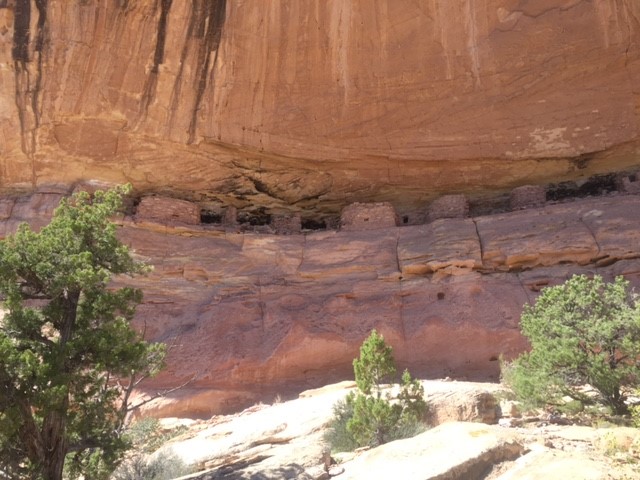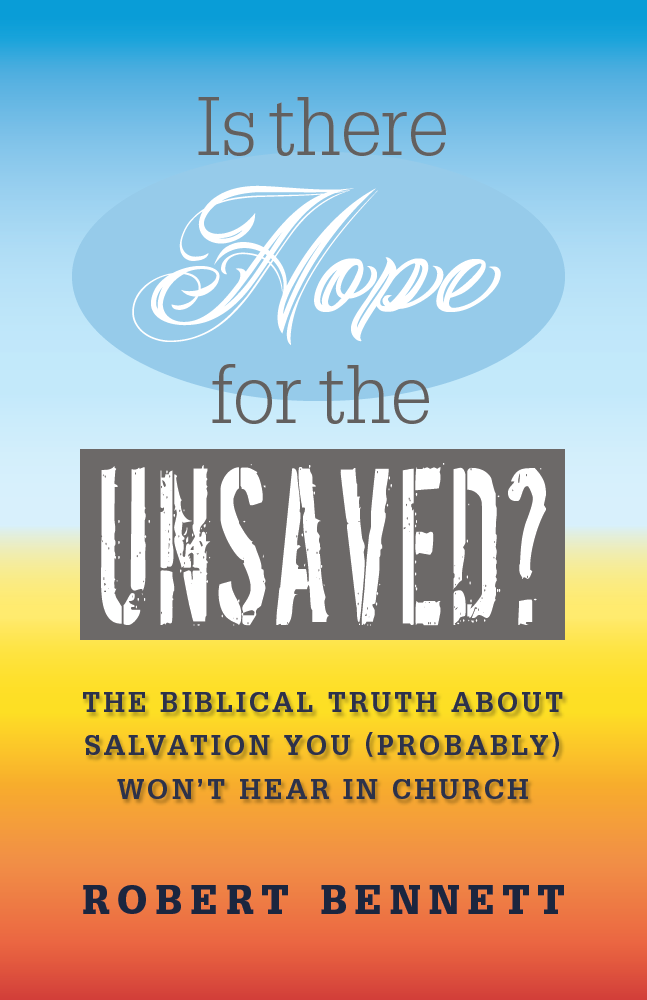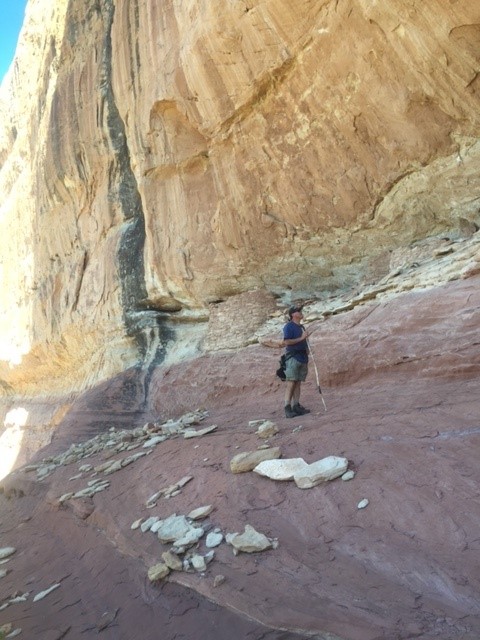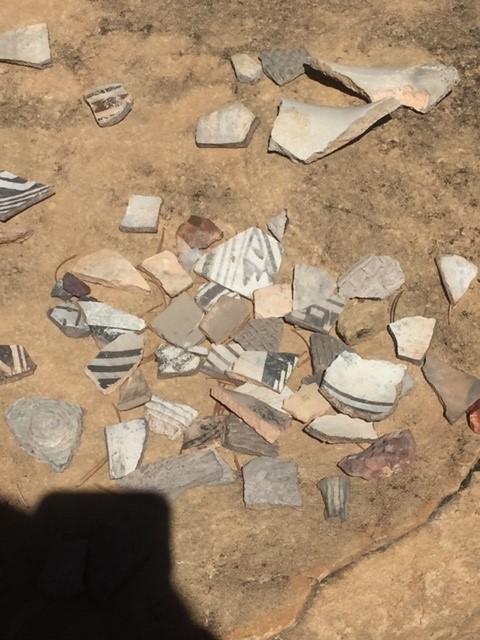I am fascinated by the Anasazi, the now-extinct people (also known as “Ancestral Puebloans”) who lived in what is now called the Four Corners region of the American Southwest, comprising southeastern Utah, northeastern Arizona, northwestern New Mexico, and southwestern Colorado. While various groups of these peoples lived in differing habitations, I am primarily captivated by the cliff-dwellers. I am one of a very tiny set of contemporaries who have seen this particular set of ruins. Quoting from my recent book, Is there Hope for the Unsaved?: The Biblical Truth about Salvation You (Probably) Won’t Hear in Church  Anasazi ruins few have seen. Photograph by Robert Bennett.
Anasazi ruins few have seen. Photograph by Robert Bennett.
“As I write these words, I am a few days removed from a backpacking trip in Canyonlands National Park in southeastern Utah. Two companions and I hiked the Salt Creek Canyon and saw some amazing sights. Steep canyons plunging twelve hundred feet creating depth and shadows. Wind and water erosion carving tiers of sandstone in differing colors and hardness into arches, mushroom rocks, and other architectural designs of God’s creative whimsy. But the most amazing discoveries to me were the remarkably intact ruins left behind by the ancient Anasazi over eight hundred years ago. Here, built into cliffs and beneath sandstone underhangs, were tiny dwellings made of small blocks of stone and mortared with adobe mud. These dwellings resemble wasps’ nests under the eaves of a house. Along with the dwellings we found crude tools for grinding maize into meal, potsherds, and even tiny corn cobs preserved by the desert clime.
As I pondered the difficult lives of the smallish people who dwelt in the cliffs in this remote canyon a thousand years ago, I considered how different these ancient people were than we moderns, or even the people at the time of Jesus. The primitive Anasazi had no written language, no metal tools or weapons, no domestic animals, no wine. Yet the promise that the eternal gospel has been preached to each person in this tribe in their own language is true if you trust in the Word of God. You see, Jesus came for these people too.”
It takes a vivid imagination to consider the lives these people lived, up there so high in the cliffs in their tiny abodes. Presumably, they built their homes in the cliffs for defensive purposes, but these communities were so remote and desolate that if invaders attacked even once a generation, it would be surprising. The problems of an existence high in the cliffs would be daunting. Sleepwalkers would be ruthlessly culled from the herd by their own disorder. The obtaining, storing and transportation of water had to have been a monumental undertaking. Even bodily eliminations would prove problematic.
Not long after I returned to Denver from my trip, I came across Rev. 7: 9-10. In this passage, God allows the Apostle John to peer into heaven and report his findings. John witnesses a great celebration.
After this I looked, and there before me was a great multitude that no one could count, from every nation, tribe, people and language, standing before the throne and before the Lamb. They were wearing white robes and were holding palm branches in their hands. And they cried out in a loud voice:
“Salvation belongs to our God,
who sits on the throne,
and to the Lamb.”
According to John’s eye-witness testimony, every tribe is represented around the throne of the Lamb, including the Anasazi. But how can this be? The Anasazi went extinct 150 years before Columbus ever set foot upon the New World. Doesn’t the Bible emphatically declare that Jesus is the Way, the Truth and the Life, and no one comes to the Father except through Jesus? (John 14: 6). So how could the Anasazi have possibly come to trust in Jesus when it would have been impossible to hear the gospel through any missionary work?
Again, the Bible is very clear the Anasazi received the gospel message. First the Apostle Paul tells us in no uncertain terms: “This is the gospel that you heard and that has been proclaimed to every creature under heaven, and of which I, Paul, have become a servant” (Colossians 1: 23b). Every creature under heaven describes the Anasazi, as well as you and me, doesn’t it?
Next, John also informs us the gospel is preached universally: “Then I saw another angel flying in midair, and he had the eternal gospel to proclaim to those who live on the earth—to every nation, tribe, language and people” (Rev. 14-6).
So, it’s clear from the above passages the Anasazi received the gospel in their own language. How could that happen? Did some mysterious shaman preach the gospel of Jesus Christ in Anasazian, or whatever the language of the Anasazi? No, almost certainly not. No, the Bible seems to clearly indicate the Anasazi (and countless other tribes) received the gospel after they died.
Listen to the words of the Apostle Peter: “For this is the reason the gospel was preached even to those who are now dead, so that they might be judged according to human standards in regard to the body, but live according to God in regard to the spirit” (1 Peter 4:6).
Still need convincing? Then hear the words from Jesus himself. He says, “Very truly I tell you, a time is coming and has now come when the dead will hear the voice of the Son of God and those who hear will live” (John 5:25, emphasis mine).
When Peter and Jesus reveal the gospel is preached to the Anasazi – and all others – upon their deaths, this concept is theologically known as post-mortem revelation. Even when the gospel is presented flawlessly upon their death, the Anasazi – like all others – have the choice to accept God’s love or reject it. Let me ask you this: Has your church ever preached or taught post-mortem revelation? Leave a comment in the comments or email me at denverbennett@msn.com.
You might understand better the subtitle in my book which explores these concepts in depth – Is there Hope for the Unsaved: The Biblical Truth about Salvation You (Probably) Won’t Hear in Church. 
Coming soon. This writer will theorize his best guess as to the mystery of the Anasazi extinction. Was it war? Famine? Drought? Mass-hysteria? Be sure to tune in.


